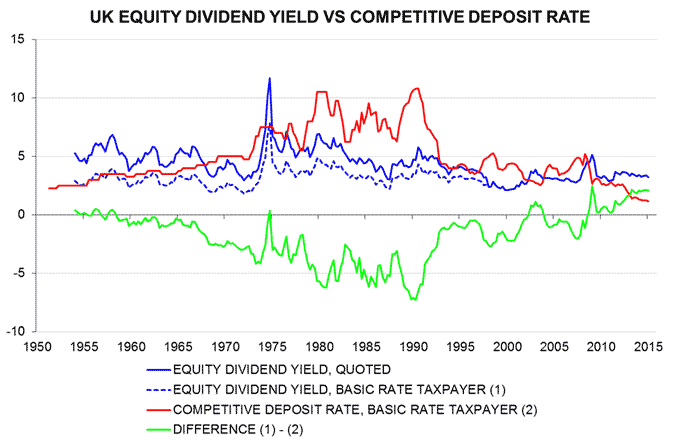UK equity / cash yield gap still wide
The gap between the dividend yield on UK equities and the interest rate on a competitive bank / building society savings account remains historically high, even taking into account the Budget decision to exempt small savers from tax on interest income.
The dividend yield on the UK market for a basic rate taxpayer is currently 3.22%, while a competitive savings account pays 1.16% net, according to Bank of England data. The 2.06 percentage point yield premium on equities is near the top of the historical range – see green line in chart*.
The maximum yield advantage of equities, of 2.46 percentage points, occurred at the bear market low in March 2009.
Equities have mostly yielded much less than cash since WW2. The yield difference averaged -1.86 percentage points between 1954 and 2014 (61 years).
The Budget introduced a £1,000 interest income allowance for basic rate taxpayers. Savers with less than £69,000, therefore, can earn the gross interest rate of 1.45%, rather than the net 1.16%. This cuts the yield premium on equities to 1.77 percentage points – still high by historical standards.
In contrast to 2009, the current wide gap reflects low interest rates rather than cheap equity prices – the net dividend yield is close to its long-run average. Income-famished savers lured from cash into shares may underappreciate the risk of a future market set-back offsetting the higher yield.
*The chart shows the dividend yield on equities on an as-published basis and net of basic rate tax. The published yield refers to actual dividends paid since 1998; basic rate taxpayers are treated as having paid tax on such dividends so the published and net yields are the same. Before 1998, the published yield was calculated on a gross basis, i.e. including a tax credit that was reclaimable by tax-exempt investors; the net yield applies the basic or standard rate of (dividend) income tax to this gross measure. The yield data refer to the FTSE all-share index from 1963 and the FT30 index for earlier years. The deposit rate series links together interest rate data for bank / building society savings products that were competitive historically. The rate used in recent years is the average quoted rate on two-year fixed-rate bonds. This series begins in 2009; the effective rate on one- to two-year household time deposits is used between 2004 and this date. Earlier figures refer to the average or recommended building society ordinary share rate.


Reader Comments